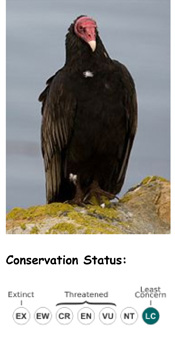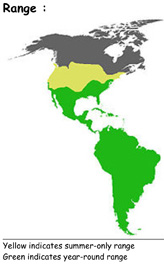Learn About Turkey Vultures
The Turkey Vulture (Cathartes aura) is a bird found throughout most of the Americas. It ranges from southern Canada to the southernmost tip of South America. It inhabits a variety of open and semi-open areas, including subtropical forests, shrublands, pastures, and deserts. With a wingspan of 173–183 cm and an average weight of 1.4 kg (3.1 lb), the Turkey Vulture is a large bird. It has dark brown to black plumage; a featherless, purplish-red head and neck; and a short, hooked, ivory-colored beak.
The Turkey Vulture received its common name from the resemblance of the adult’s bald red head and its dark plumage to that of the male Wild Turkey, while the name “vulture” is derived from the Latin word vulturus, meaning “tearer,” and is a reference to its feeding habits.
The Turkey Vulture is a scavenger and feeds almost exclusively on carrion. It finds its meals using its sense of smell, flying low enough to detect the gasses produced by the beginnings of the process of decay in dead animals. Unlike the other birds of prey, their feet are flat, relatively weak, and poorly adapted to grasping; the talons are also not designed for grasping, as they are relatively blunt.
In flight, it uses thermals to move through the air, flapping its wings infrequently. They can soar air currants for hours without flapping their wings once. It roosts in large community groups. Lacking a syrinx—the vocal organ of birds—its only vocalizations are grunts or low hisses. It nests in caves, hollow trees, or thickets, each year generally raising two chicks, which it feeds by regurgitation.
This vulture is often seen standing in a spread-winged stance. The stance is believed to serve multiple functions: drying the wings, warming the body, and baking off bacteria.
The Turkey Vulture often defecates on its own legs, using the evaporation of the water in the feces and/or urine to cool itself, a process known as urohydrosis. It cools the blood vessels in the unfeathered feet, and causes white uric acid to streak the legs
The turkey vulture is the most abundant vulture in the Americas. Its global population is estimated to be 4,500,000 individuals.
It has very few natural predators. Its primary form of defense is regurgitating semi-digested meat, a foul-smelling substance which deters most creatures intent on raiding a vulture nest. It will also sting if the predator is close enough to get the vomit in its face or eyes. In some cases, the vulture must rid its crop of a heavy, undigested meal in order to take flight to flee from a potential predator.
The breeding season of the Turkey Vulture commences in March, peaks in April to May, and continues into June.
Eggs are generally laid in the nesting site in a protected location such as a cliff, a cave, a rock crevice, a burrow, inside a hollow tree, or in a thicket. There is little or no construction of a nest; eggs are laid on a bare surface. Females generally lay two eggs, but sometimes one and rarely three. The eggs are cream-colored, with brown or lavender spots around their larger end. Both parents incubate, and the young hatch after 30 to 40 days. Chicks are helpless at birth. Both adults feed the chicks by regurgitating food for them, and care for them for 10 to 11 weeks. When adults are threatened while nesting, they may flee, or they may regurgitate on the intruder or feign death. If the chicks are threatened in the nest, they defend themselves by hissing and regurgitating.

Scientific Classification:
- Kingdom: Animalia
- Phylum: Chordata
- Class: Aves
- Order: Incertae sedis (disputed)
- Family: Cathartidae
- Genus: Cathartes
- Species: C. aura


References: *”Species factsheet: Cathartes aura”. BirdLife International. Retrieved on 2007-10-13. * “2007”. Britannica Concise Encyclopedia. Encyclopædia Britannica. Retrieved on 2007-10-14. *Hilty, Stephen L. (1977). A Guide to the Birds of Colombia. Princeton University Press. pp. 87 *Attwood,, E. “Cathartes aura”. University of Michigan Museum of Zoology. Retrieved on 2007-09-30. *Miskimen, Mildred (January 1957). “Absence of Syrinx in the Turkey Vulture (Cathartes Aura)” (PDF). The Auk 74 (1): 104–105. http://elibrary.unm.edu/sora/Auk/v074n01/p0104-p0105.pdf. Retrieved on 24 October 2006. *Fergus, Charles (2003). Wildlife of Virginia and Maryland Washington D.C.. Stackpole Books. p. 171. *Snyder, Noel F. R. and Helen Snyder (2006). Raptors of North America: Natural History and Conservation. Voyageur Press. *”Birds Protected by the Migratory Bird Treaty Act”. US Fish & Wildlife Service. Retrieved on 2007-10-14. *Holloway, Joel Ellis (2003). Dictionary of Birds of the United States: Scientific and Common Names. Timber Press. pp. 59. *”Turkey Vulture”. Birds of Texas. Texas Parks & Wildlife (2001). Retrieved on 2007-10-29. *Liddell, Henry George; Robert Scott (1980). Greek-English Lexicon, Abridged Edition. Oxford: Oxford University Press. *Linnaeus, Carolus (1758). Systema naturae per regna tria naturae, secundum classes, ordines, genera, species, cum characteribus, differentiis, synonymis, locis. Tomus I. Editio decima, reformata.. Holmiae. (Laurentii Salvii).. pp. 86. *Remsen, J. V., Jr.; C. D. Cadena; A. Jaramillo; M. Nores; J. F. Pacheco; M. B. Robbins; T. S. Schulenberg; F. G. Stiles; D. F. Stotz & K. J. Zimmer. 2007. A classification of the bird species of South America. South American Classification Committee. Retrieved on 2007-10-15 *Sibley, Charles G. and Burt L. Monroe. 1990. Distribution and Taxonomy of the Birds of the World. Yale University Press. ISBN 0-300-04969-2. Accessed 2007-04-11. *Sibley, Charles G., and Jon E. Ahlquist. 1991. Phylogeny and Classification of Birds: A Study in Molecular Evolution. Yale University Press. *Ericson, Per G. P.; Anderson, Cajsa L.; Britton, Tom; Elżanowski, Andrzej; Johansson, Ulf S.; Kallersjö, Mari; Ohlson, Jan I.; Parsons, Thomas J.; Zuccon, Dario & Mayr, Gerald (2006): Diversification of Neoaves: integration of molecular sequence data and fossils. Biology Letters online: 1-5. *Amadon, Dean (1977), “Notes on the Taxonomy of Vultures” (PDF), Condor 79 (4): 413–416, *Blake, Emmet Reid (1953). Birds of Mexico: A Guide for Field Identification. University of Chicago Press. pp. 267. *Peters J. L.; Mayr E.& Cottrell,W. (1979). Check-list of Birds of the World. Museum of Comparative Zoology. pp. 276. *Brown, Leslie & Amadon, Dean (1968). Eagles, Hawks, and Falcons of the World. McGraw-Hill. pp. 175 *Hill, N. P. (1944). “Sexual Dimorphism in the Falconiformes” (PDF). Auk 61 (April): 228. *Terres, J. K. (1980). The Audubon Society Encyclopedia of North American Birds. New York, NY: Knopf. pp. 959. *Fisher, Harvey I. (Fabruary), “The Pterylosis of the Andean Condor”, Condor 44 (1): 30–32. *Feduccia, J. Alan (1999). The Origin and Evolution of Birds. Yale University Press. pp. 116. *Elbroch, Mark (2001). Bird Tracks & Sign. Mechanicsburg, PA: Stackpole Books. pp. 456. *Allaby, Michael (1992). The Concise Oxford Dictionary of Zoology. Oxford, UK: Oxford University Press. pp. 348. *”Turkey Vulture”. Cornell Lab of Ornithology (2003). Retrieved on 2007-09-30. *Kirk, D. A.; Mossman, M. J. (1998), “Turkey Vulture (Cathartes aura)”, in A. Poole and F. Gill, The Birds of North America, 339, Philadelphia, PA.: The Birds of North America, Inc. *Golden Gate Raptor Observatory: Rare Raptors. Retrieved 2007-09-17. *Kaufman, Kenn (1996). Lives of North American Birds. Houghton Mifflin Field Guides. pp. 112. *Ridenhou, Larry. “NCA – Turkey Vulture”. Snake River Birds of Prey National Conservation Area. Bureau of Land Management. Retrieved on 2006-12-17. *Gordon, Malcolm S. (1977). Animal Physiology: Principles and Adaptations. Macmillan. pp. 357. *”Turkey vulture, Cathartes aura”. U.S. Geological Survey. Retrieved on 2007-09-30. *Pinto, O. M. O., Dos frutos da palmeira Elaeis guineensis na dieta de Cathartes aura ruficollis. Hornero 8: 276-277, 1965; Mauro Galetti & Paulo R. Guimarães Jr., “Seed dispersal of Attalea phalerata (Palmae) by Crested caracaras (Caracara plancus) in the Pantanal and a review of frugivory by raptors”, Ararajuba 12 (2):133-135, December 2004; avaliable at www.ararajuba.org.br/sbo/ararajuba/artigos/Volume122/ara122not1.pdf *Kritcher, John C. (1999). A Neotropical Companion. Princeton University Press. pp. 286. *Gomez, LG; Houston, DC; Cotton, P; Tye, A (1994). “The role of greater yellow-headed vultures Cathartes melambrotus as scavengers in neotropical forest”. Ibis 136 (2): 193–196. * Muller-Schwarze, Dietland (2006). Chemical Ecology of Vertebrates. Cambridge University Press. p. 350. *”Species Description: Turkey Vulture (Cathartes aura)”. Georgia Museum of Natural History. Retrieved on 2007-10-14. *Kirk, D. A., and M. J. Mossman. 1998. Turkey Vulture (Cathartes aura). In The Birds of North America, No. 339 (A. Poole and F. Gill, eds.). The Birds of North America, Inc., Philadelphia, PA. *Paulik, Laurie (2007-08-06). “Vultures and Livestock”. AgNIC Wildlife Damage Management Web. Retrieved on 2007-10-15. *Paulik, Laurie (2007-08-06). “Vultures”. AgNIC Wildlife Damage Management Web. Retrieved on 2007-10-15. *”Migratory Bird Treaty Act”. US Code Collection. Cornell Law School. Retrieved on 2007-10-14. *”Game and Wild Birds: Preservation”. US Code Collection. Cornell Law School. Retrieved on 2007-10-29.

